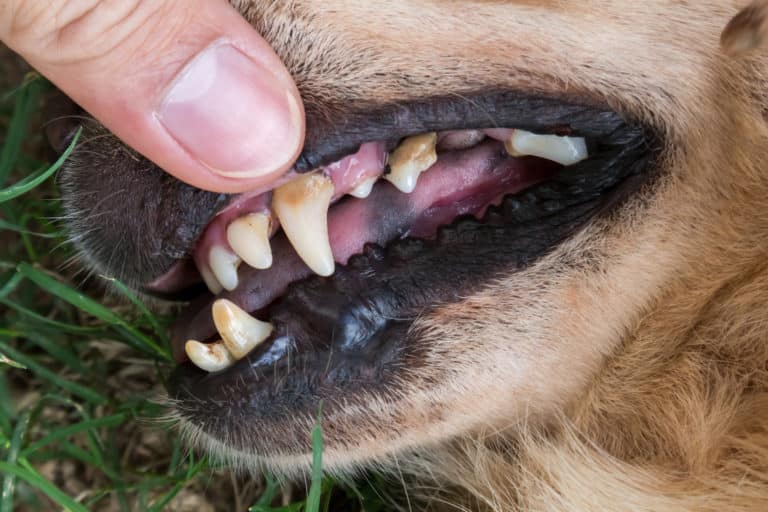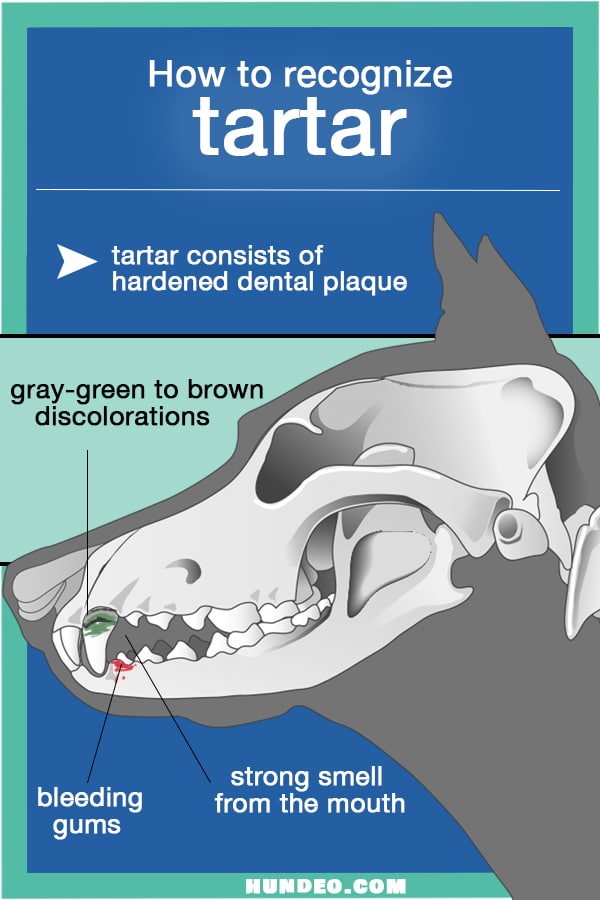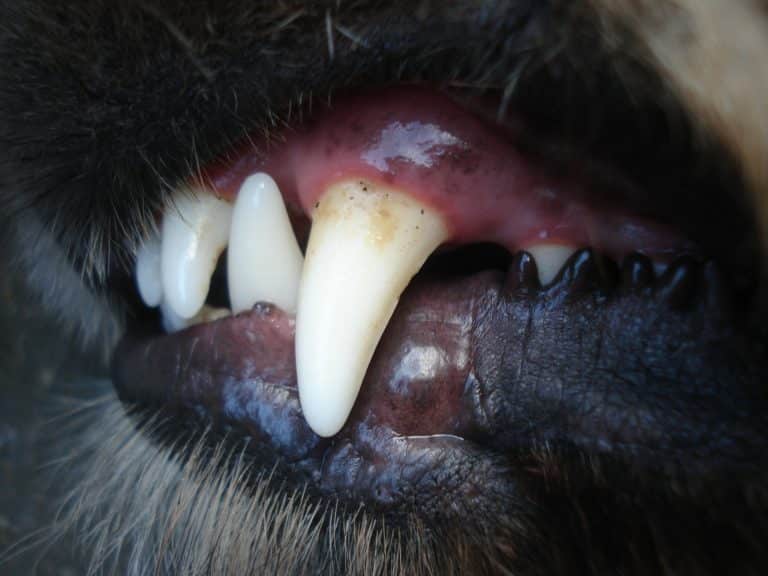Tartar in dogs (4 tips for immediate help)
- Veterinarian Mag.med.vet. Emin Jasarevic
- Updated: 2024-02-05
Your dog has tartar? You can find out how to get rid of it on your own and how to care for your teeth properly in this article. Plus the most important tips for immediate help. We have also obtained advice for this article from veterinarian Mag.med.vet. Emin Jasarevic for this article. So stay tuned.

Tartar can have serious consequences if left untreated.
How is tartar formed?
After every meal our dogs eat, food residues remain attached to their teeth. Normally, these are loosened by chewing a bone, for example, and then removed by saliva.
There are numerous bacteria in the mouth. But don't panic, most of them are good for the body and help decompose the food. The "bad" bacteria are killed by the immune system.
However, if the food residues cannot be removed properly, they are a found food for certain bacteria.
These then multiply and, together with food residues, minerals from saliva and bacteria from the oral mucosa, form a solid layer on the tooth surface. Since these are mostly plaque bacteria, this layer is also called plaque.
The plaque has a rough surface. This makes it easy for new bacteria to adhere to it and the layer continues to grow. If it is very hard and visible to the naked eye, it is called tartar.
What should I look for in the food?
Tartar is not uncommon in furry noses. Dental hygiene may not be as thorough as in humans, so food debris keeps getting stuck in the teeth. There are also additional factors that increase the risk in dogs.
Bacteria feed mainly on sugar. If your pet ingests a lot of sugar through their food, this is a feast for the bacteria in their mouth. They multiply more and are more persistent. The starch contained in cereal products is also enthusiastically welcomed by bacteria.
That is why sugary foods and cereals are a risk for tartar.
A complete switch from dry food to wet food also favors tartar. The teeth are cleaned by the abrasion caused by chewing the dry food. This mechanical cleaning is missing with wet food.
The risk with small breeds
Small dogs are much more at risk of getting diseases through their teeth. This includes tartar. The shorter muzzles created by breeding no longer provide enough space for the many teeth. The result is often misaligned teeth.
Since the very narrow interdental spaces cannot be cleaned while chewing, bacteria and food debris quickly settle.
In addition, small dogs pant more often. Constant panting dries out the mucous membrane more quickly and there is too little saliva in the mouth. Bacteria and food residues settle more easily and tartar forms after some time.
Tooth loss possible
If the tartar is not treated, the bacteria also attack the gums. As a result, it becomes inflamed and gum pockets develop, i.e. cavities where the teeth attach to the gums. The bacteria can now also settle here. The gums are thus pushed back further and further and the teeth appear larger.
This process damages both gums, teeth and bone. If this remains untreated, the tooth loosens after some time and falls out.
Of course, you should not wait so long with this problem, because this process can be very painful. As a result, the four-legged friends eat less because they have a toothache or simply gulp down the food instead of chewing it properly. The gulping down of the food can lead to vomiting or gastrointestinal discomfort.
Through gum pockets, which are ultimately wounds, bacteria can easily enter the bloodstream and affect organs throughout the body. Thus, in some cases, kidneys, liver or even the heart can be damaged.
Therefore, you should not let it get that far in the first place and remove tartar in time.
How to recognize tartar

Tartar consists of hardened dental plaque. These have a hard substance and are rough on the surface. As a result, new plaque keeps forming on it and the tartar grows larger.
You can recognize tartar in your pet by a gray-green to brown discoloration. It usually starts at the base of the tooth and spreads over the tooth.
In most cases, the canines, fangs and molars of the upper jaw are affected. Plaque is predominantly found on the tooth surface, occasionally also in the gum pockets. So look closely not only at the teeth, but also at the transition from gum to tooth.
Tartar is usually accompanied by a strong mouth odor. Gum inflammation can also lead to bleeding gums. If the inflammation is severe, the tooth may even fester.
Your faithful friend probably has toothache due to tartar. For you as the owner, however, this is usually difficult to recognize, as dogs often cover up minor pain. You can recognize the pain by the fact that your pet eats less as a result.
What you can do against tartar
If you discover discoloration and plaque on your dog, don't wait long to help him. If the tartar continues to harden or grow larger, it will also become more difficult to remove.
1. remove yourself
If you're feeling up to it, you can scrape the tartar off your dog's teeth yourself.
If it is still simple plaque and not solid tartar, you can carefully remove it with a toothbrush. Use either a special dog toothbrush or one with soft bristles.
If the plaque is stubborn and cannot be removed easily, you can apply a special dental gel beforehand. The enzymes it contains soften the tartar. You also don't have to worry if your pet licks the gel. It is safe for dogs to eat.
If the teeth have already been pre-treated, you can now carefully scrape off the tartar. You should use a special tartar remover set for this. You are probably already familiar with similar scratches from the dentist.
However, this method only works if your furry friend remains calm and puts up with the dental treatment.
2. have removed by the veterinarian
If you are not confident enough to remove the tartar yourself or your dog is not calm enough, the vet can remove the tartar under anesthetic.
You should also go to the vet if your pet has a severe toothache, refuses food, or his gums are bleeding.
The vet removes the tartar using a dental ultrasound device. This procedure takes place under anesthesia. Unfortunately, it is quite expensive. Depending on the vet and the severity, you can expect to pay several hundred euros. There is also the risk of anesthesia for your dog.
You must decide for yourself to what extent this intervention is necessary. You can also ask your veterinarian for advice.
4 Tips for prevention

1. species appropriate diet
A poor diet can be largely responsible for tartar. However, if you make sure that your dog's food does not contain sugar and grains, your pet's teeth will stay healthy for longer.
Dry food is usually better for the teeth than wet food. Due to its firm consistency, less food residue is left behind. In addition, dry food supports self-cleaning of the teeth through abrasion.
2. dog toys for chewing and chewing bone
The more your four-legged friend chews on solid things, the better he cleans his own teeth. There are special dog toys for chewing and nibbling. Natural chewing bones and gristle also contribute to your dog's dental health.
3. get used to dental checks
Getting your dog used to dental checkups when he's still a puppy will make this procedure easier in a pinch.
From the very beginning, you should look at your pet's teeth regularly and carry out check-ups. You can also brush his teeth carefully. To do this, you should use toothbrushes with a soft brush and a special dog toothpaste.
4. dental care gel for prevention.
There are dental care gels for dogs that kill bacteria in the mouth. This prevents them from settling and prevents tartar from forming in the first place. Apply the gel regularly to your dog's teeth. You can use soft toothbrushes or gloves for this.
Frequently Asked Questions
Your dog can get diseases in his mouth, just like humans, if his dental hygiene is neglected. These include tooth decay or gingivitis, which can cause pain.
To maintain your dog's dental health, it is recommended to brush his teeth once a day. You should also provide him with enough chew toys, so he can help clean his teeth himself.
You will need a dog toothbrush and special toothpaste. Get your dog used to brushing his teeth slowly, without pressure and from an early age. You can find detailed step-by-step instructions in our article.
Bad breath in your dog is a sign of too much plaque on the teeth or of tooth decay and gingivitis. In any case, you should take care of oral hygiene if your dog has bad breath.
Like human babies, puppies first develop milk teeth before they grow permanent teeth. The change of teeth takes place around the 16th week of life.
Veterinarian’s Recommendation
Unfortunately, discoloration of our dogs' teeth is often underestimated. But they are not only a visual problem, because they can also bring serious consequences.
Tartar does not get better without treatment. Quite the opposite: it gets bigger and bigger over time. In the worst case, it can even lead to tooth loss. You should therefore avoid risk factors such as food containing sugar and cereals and check your dog's teeth regularly.
Thus, your four-legged friend can continue to live without toothache and annoying tartar removal.

I am a veterinarian and writer on animal health topics. Animals are my passion, and it is my personal goal to create medically accurate articles and videos to educate pet owners as much as possible.
Share Now:

